ShopDreamUp AI ArtDreamUp
Deviation Actions
Welcome to Dramatic Insights! Please support our efforts and fav this article by clicking the  in the top left corner.
in the top left corner. 
I’m very excited about this issue all about Macro & Close Up Photography!! Packed full of useful tips and helpful advice from some our top members, I invite to grab a cup of coffee and enjoy!!

 Wanted: Awesome HDR work!!! Our next edition of Dramatic Insights will focus on High Dynamic Range (HDR) Photography! If you would like your work to be considered for this exciting article just comment on the current blog at Dramatic-Photography
Wanted: Awesome HDR work!!! Our next edition of Dramatic Insights will focus on High Dynamic Range (HDR) Photography! If you would like your work to be considered for this exciting article just comment on the current blog at Dramatic-Photography  Please note that you must be a member of Dramatic Photography to participate and all applicants will be qualified by their body of work on the topic, although we do features artists of varying skill levels.
Please note that you must be a member of Dramatic Photography to participate and all applicants will be qualified by their body of work on the topic, although we do features artists of varying skill levels.
_______________________________________________________________________

Dramatic-Photography was created to showcase high quality photography with a special flare for the dramatic! We have a lot to offer talented photographers including the opportunity to be a Featured Artist in an issue of Dramatic Insights, Daily front page features, Weekly Member Features, Valuable Exposure and our upcoming Dramatic Photographer of the Year Competition where one of our members will win BIG.
 Dramatic Insights is a bi-weekly publication featuring Dramatic-Photography members selected work along with insights into their world behind the camera.
Dramatic Insights is a bi-weekly publication featuring Dramatic-Photography members selected work along with insights into their world behind the camera. 
_______________________________________________________________________
Special thanks to our Featured Artists in this Edition for sharing their knowledge and inspiration. :




















_______________________________________________________________________

Macro shot is so interesting & really fun. It's not easy to take macro shots, maybe these three simple things can help you all:
1. I recommend you use manual focus while taking macro shot. Because usually the insects you want to shot are moving, so it's better we set it to manual focus and only move our body forward & backward.
2. Using a small aperture gives us problems too with light. So sometimes I use flash to give more light but I set it with really low power so we can still get natural ambient.
3. And I think we should have good level of concentration & really patient waiting for the moment.
I hope they are useful, Thank You





_______________________________________________________________________

The three "tips" I can share about macro photography would be:
1) Open your eyes!!! There are so many tiny things in our world that usually don't get any recognition, like when was the last time you looked at a water drop falling into the sink? Or when did you last admire the incredible details of a bug's eye (eyes)? Find the miniature world and shoot it!
2) Know your gear!!! Understand that the closer you can get the shallower your focus will be, the more light (or time) you need to capture a reasonable depth of field, etc. Also, if you really dig macro photography, consider investing in a macro lens.
3) Be creative!!! How many times have you seen a drop on a pedal, or a bug's face, or the stamen of a flower? I would say often, and I created (and still do) quite a few of them myself. But find new ways to show the tiny world - that is a goal well worth striving for and I am trying to get there myself. Good luck to us all!
 :thumb156649469:
:thumb156649469:
 :thumb174955925:
:thumb174955925:
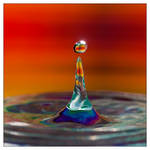
_______________________________________________________________________

1 First of all, I think that to do macro photography you don't need a professional camera and lens; or, if you don't have it, it is not an insuperable problem. In fact my camera is simply a NIKON COOLPIX with 10 mega pixel, but I don't have any type of lens. So I try to do nice macro photograps without professional camera. This is possible: see my work! Obviously we CAN'T have the same results that we would have with a professional camera and lens, BUT we can always enjoy ourselves trying to make something cute and magic with some devices.
2 The most important thing, the first thing ever that we have to do is the choice of the subject, I love particularly flowers, and the framing. A subject isn't the same photographed by different angles. Just try and try and try, until we find the best shot.
3 Then we have to add to the photo something "magic"; how to do this?? with the EDIT! I think edit is what can give to the photo something ours, something of what we are, what we think. Because we can donate to our image the "light" that we want: warm and vivid colours, or we can give a vintage tone, we can exalt the details and we can add also bokeh ( something beautiful I think!! )


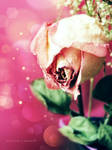


_______________________________________________________________________

Here are my three tips for macro and close up photography:
1. Make sure your focusing is perfect: When your depth of field is down to just millimetres, the tiniest error in focusing can throw the image completely out of focus, and as the small detail tends to be the main area of interest in macro photography, you don't really have any room for error.
2. Use a tripod: Whilst this is not going to be possible with any fast moving subjects such as insects, a tripod can make precise focusing a million times easier if you have a stationary subject. Just make sure that you turn off image stabilisation if your lens has it, and use the mirror lock up function and either self timer or cable release so that tiny vibrations don't mess up your perfect focusing. Using a tripod also helps with your composition as it slows down your work and makes you really think about what you are doing.
3. Make sure that your equipment and subject is clean: Whilst something like a flower may look fine from a distance, macro or close up photography will show up every single speck of dust or dirt. It is easier to remove any dirt etc before you start shooting, rather than trying to clone them out later. The same goes for your equipment. Dust on your lens can wreck your photos, and is much more difficult to photoshop out than dirt on the subject.
:thumb119693608::thumb106959452::thumb89772076::thumb119697839::thumb146846333:
_______________________________________________________________________

1. A tripod is always useful when shooting macro, that way you have less chance that your photo will be moved.
2. Play with the settings of your camera to get exactly the photo that you want
3. If you want to photograph moving things like an insect than its best to shoot with fast shutter time and if you have the chance then its best if you shoot in the morning, an insect needs time to warm up and fly away, so you will have the time to photograph your subject!





_______________________________________________________________________

Here are my macro tips:
Nearly all of my macro photography involves wildflowers, so my tips are in that context:
Tip One: Invest in a REAL macro lens! For the past five years I have been using a Sigma 105mm f/2.8, and I love it!
Tip Two: The wind is your enemy! Do everything in your power to block the wind. Some of my fellow wildflower photographers have constructed small boxes which they carefully place over their subject to isolate it from the elements.
Tip Three: Use your fastest aperture! There are two benefits to this approach: (a) Your shutter speed will be extremely fast, which will give you a better chance of keeping your subject in focus; and (b) you will achieve shallow depth-of-field which will more effectively separate your subject from the background.
Tip Four: Never use auto-focus! My process is "focus bracketing". After deciding upon the composition, I take several dozen shots and make very slight changes with the focus ring between each shot. Obviously I don't keep all of these, but I can be assured that I will have at least one shot with acceptable focus.


 :thumb16932830:
:thumb16932830:
_______________________________________________________________________

I'm far from being professional macro photographer but I'll give three simple tips I think are important for beginners:
- Sharp focus is necessary. So use a small aperture (large F value) to maximize the amount of the image in focus.
- Use manual focus. Allowing the camera to choose by auto focusing may mismatch with where you want to focus. So if your camera allows manual focusing select this option and manually focus on the part of subject that is the main point of interest.
- Fill the photo with your subject and try shooting from different angles. Be creative but don't forget about basic rules of composition like the Rule of Thirds.

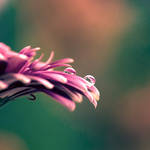



_______________________________________________________________________

Here are my tips and suggestions along with my five choices of macro and close-up shots from my gallery:
1)Get up close and personal with what you are photographing even if this means splashing around in mud and water, hanging upside down from stone walls or rail fences, perching uncomfortably in trees or worming your way through small dusty spaces in order to get that close up or macro shot. I may not have a DSLR for a camera but I push my little professional point-n-shoot to it's limits to get as close as possible.
2)Choose to focus in on one small portion of the whole photo instead of the whole object is in focus. You can create a lot of visual interest and completely different moods by focusing in on one small area and leaving the rest slightly out of focus. I have discovered many new ways to look at ONE flower by using this approach.
3)Look for unusual or unique angles to shoot from. Use light sources such as the sun to shine through and illuminate rather than harshly light the whole surface. Instead of shooting just the petals of a flower, let your camera open up the petals to let the sun in and discover what the middle of the flower looks like when a shaft of light illuminates just one small portion of the center. Shoot up from underneath and let the sky be your contrast and background.


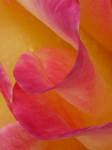

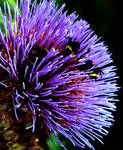
_______________________________________________________________________

The three things I see as very important for macro photography are:
1. Patience
Bugs hole up, butterflies fly away, and sometimes it seems that even water drops don't want to be photographed. It's hard not to give up or just take a picture which is okay, but not satisfying.
Don't give up the vision of what you want to create and try as long as it takes.
2. Be a early bird
Insects are ectotherm. That means that when it's cold outside they can hardly move. That's a good chance for taking pictures.
3. Light
You'll get a very beautiful light when you consider the 'magical hour'. This is the first and last hour of sunlight during the day.


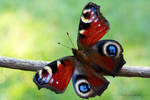


_______________________________________________________________________

My tips
Use tripod to take sharp and clean, no noisy, no blurry shots without usage too high iso. If you take outdoor shots you can use something to hold stable the subject of your photo too. It is good if you have a few little forceps, a scissors in your bag when you would take macro shots, they can be useful.
Listen to the details because sometimes you could find disturbing little things on your photos after download them because of the dirty front lens or could be some other mess on your subject too. To avoid this keep always clean your equipment. You could remove them with afterwork too but the easier way is to take a correct shot.
Try to find and show interesting details and accent the most important part of your shot with the composition, with the right angle of view and the properly chosen depth of field. To get unsharp background use macro or tele lens with the suitable F number.
Macro world is really interesting so good exploration!

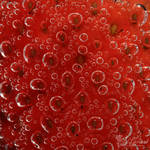

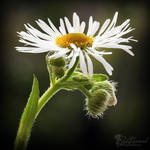
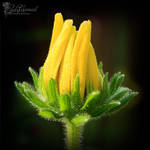
_______________________________________________________________________

1. The most important is patience. A lot of patience is needed to take photos of active and skittish insects. We have to be aware of the fact that if we came up to the insect it may run away. We shouldn't become discouraged and keep on trying taking pictures.
2. When it is hard to take photos of insects during the day because of their activeness and wide-awakeness, the best solution is to take them really early at the morning when they are still asleep. Waking up at 4 or 5 could be burdensome but it is worth it. Without sacrificing you will not get the photos about which you are dreaming of. It is also good to take a tripod with you. It could be very helpful.
3. Continuous observation of the species can develop our knowledge about the habits of animal, which then can be used while taking photos. It really helps the photographer to predict the next steps of the insects and can be useful while searching the individuals. Simultaneously it is very pleasant and relaxing activity.





_______________________________________________________________________

1. See how other artists shoot. Get inspiration in their work but never copy them. Try to discover what settings & lighting they used and try to make your own set. If necessary check some tutorials here on DA.
2. Use more than one angle. Try different things and different approaches. If necessary break some rules of photography to catch the moment.
3. Have patience, mess around with DOF, Aperture, Shutter Speed and take several shots until you are pleased with the results.





_______________________________________________________________________

My three tips I would give for macro or close-up work are:
1. Turn off the auto focus and focus manually.
2. Use the smallest aperture you can depending on how much light you have. A ring light flash works great for macro work.
3. Try to position the camera so that the plane of the camera is parallel to the plane of the subject so that you have as much of the subject as possible in the narrow depth of field.





_______________________________________________________________________

Hi!
Now, my 3 tips? Hmm.. that would be:
1. Use tripod whenever you can. We all want razor sharp images when shooting macro and one way to achieve this it by using tripod. It's much easier to keep camera steady on a tripod then handheld, especially when shooting at 1:1 ratio.
2. I recommend using local focal length, at least 90mm (if you shooting indoor then it's not that important but you're out on the field most of the time anyway). It's good to have a more space to work with especially when shooting insects when you don't want to scare off your subject and keeping good ratio at the same time.
3. Equip yourself with flash/ring flash. The ring flash is a must for any pro macro photographer and if you're really looking into shooting good macro I recommend getting one fast. You'll end-up buying one anyway, it's just a matter of time . Why? Because quite often you will be in situation when daylight to lit your subject. Plus it will allow you to use higher shutter speed while keeping low ISO.
. Why? Because quite often you will be in situation when daylight to lit your subject. Plus it will allow you to use higher shutter speed while keeping low ISO.
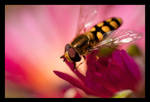




_______________________________________________________________________

Since I’m not a professional and I’m new to this passion, my tips are simple. Most of my macro photos are taken only with my compact camera. I’m new to dlsr so I don’t have any special equipment like macro lenses, extension tubes and closed-up filters. These simple tips of mine are the basics, I think, especially to beginners (like me ).
).
1. Light = plays very important rule. You should have more light to capture great macro. More light will give more details to your subject. You can use flash.
2. Tripod= tripod is good when shooting a non-moving or slow moving subject (example: dices, water drops, cut-flowers[Stable flowers], or even a not moving bug) But when you shot butterflies for example, make sure the image stabilizer is “ON” to lessen camera shake. Some dslr cameras the stabilizer mode is on the lenses. My compact camera has image stabilizer. I’m not sure if all compact cameras have this stabilizer. If using tripod use timer to prevent shakes.
3. BE PATIENCE! = Macro or close-up photography needs more patience. Wait for a moment to capture a great scene. Shot as many as you can. And be creative as well.
My additional tips is to remember the DOF Rule “The closer you are in the subject, the thinner the DOF”
Have fun shooting





_______________________________________________________________________

1. Go slow and be patient. Watch the bug for awhile to see how it behaves. Try not to cast your shadow on the bug. If the bug takes off, be still and wait a minute or two, it will often return to the same perch.
2. Use manual focus. Lock the focus and then gently move the camera forward and backward until you find the sweet spot if you want to achieve maximum magnification.
3. Use as small aperture (large F value) as possible to ensure enough depth of field. The more magnification, the less depth of field.

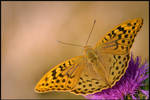

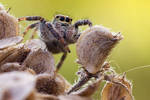

_______________________________________________________________________

Here are my three tips from me:
1. I always take the time to walk around the location I am photographing and look for all the different angles I have available to me.
2. Tell the whole story. Don’t take only one photograph. Shoot both vertical and horizontal photographs. With a lot of different photographs, you can tell the whole story.
3. I always try to be aware of the background. The background can make or break a good photograph.
Thumbs:





_______________________________________________________________________

Macro & Close Up Photography doesn't need expensive equipment and exotic locations to look great, and hopefully these three tips can show this
You needn't go out and buy a real Macro lens, when I started getting interested; I bought some close up filters, which are basically just a magnifying glass that screws into the filter thread of your lens. - Probably the cheapest option. Then I progressed to another cheap accessory, a reversing ring - this allows you to mount your lens backwards onto the camera body so it can focus more closely to the subject but since all electrical connection is lost you have to work totally manually and can be a bit tricky. I now use a manual focus 50mm prime lens with second-hand extension tubes, these give great results and are easier to work with, as the lens stays at maximum aperture until you press the shutter release. - You don't have to spend a fortune on twin flash or ring flash units either; I get great results using this home made accessory zeenon.deviantart.com/journal/…
Location for me is usually my front or back garden, once you start looking closely at bugs, they seem exotic anyway
Even the slightest breeze at this magnification can be bothersome, and a lot of times you have to hold the plant that your critter is on steady with a spare finger and thumb . Autofocus isn't worth it here, the depth of field is quite minimal, and I find rocking your body back and forward till you see the subject come into focus is the best and most natural way to work.
. Autofocus isn't worth it here, the depth of field is quite minimal, and I find rocking your body back and forward till you see the subject come into focus is the best and most natural way to work.
You don't have to get out in the field with your camera for good macro, when I'm out walking, if I find anything that looks like it would make a good shot, I pop it in a bag and take it home. You can then work inside with a tripod, a couple of table lamps (or good old window light) and a cup of coffee Drinking straws, clothes pegs and blue tack can all be pressed into service for posing your subjects, that's what I use!
Drinking straws, clothes pegs and blue tack can all be pressed into service for posing your subjects, that's what I use!



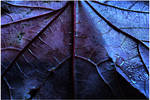

_______________________________________________________________________

Tips:
1. Tripod!!! ! Macro shots are hard to handhold and get a sharp photo.
2. Background and aperture adjustments. Try different backgrounds and check your bokeh.
3. Get closer, then get closer some more and BRACKET!





_______________________________________________________________________

While macro and close-up photography are two distinct areas, they also have much in common. Macro photography requires that you're able to shoot in full life size, which is defined as a magnification ratio of 1:1 or higher. For this you'll need some special equipment like a macro lens, bellow, or at least one or more macro filters in front of your normal lens. Close-up photography is for everybody since it only requires that you get as close up and personal to your subject as possible, with the equipment you already have.
When you find something interesting to shoot, try to create a composition which allows you to isolate your subject from the surroundings. A simple or non-cluttered background helps the subject to stand out. If you have some unwanted items in the background, try to use a larger aperture (smaller number) in order to blur them out. Focusing is most essential, of course, and you should always place your focal point on the main point of interest. I usually take several shots of a current scene and at the same time varying my settings slightly. I may also try different angles, if possible, to see what works best. Remember, it doesn't cost you anything to fill up your memory card.





_______________________________________________________________________
 Special Features
Special Features 


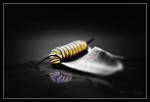 :thumb184283174:
:thumb184283174:




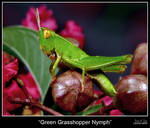 :thumb173532742:
:thumb173532742:
 :thumb129475278:
:thumb129475278:


 :thumb183982604::thumb182857452:
:thumb183982604::thumb182857452:
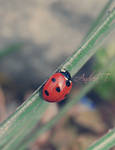

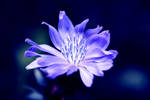 :thumb100611702:
:thumb100611702:

 :thumb150301099:
:thumb150301099:

 :thumb183203652:
:thumb183203652:

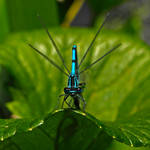


 :thumb150006958:
:thumb150006958:

 :thumb185070066::thumb179013556:
:thumb185070066::thumb179013556:
_______________________________________________________________________
And a huge Thank You to the following Affiliate for supporting this issue of Dramatic Insights!! I hope you have enjoyed the article and that you will check out these fantastic groups!!
 DreamFreeNature ( Dream Free Nature ) is a group devoted to letting you be free in submitting art about nature! Your work must be a photograph of nature to be available for entry.
DreamFreeNature ( Dream Free Nature ) is a group devoted to letting you be free in submitting art about nature! Your work must be a photograph of nature to be available for entry.
I’m very excited about this issue all about Macro & Close Up Photography!! Packed full of useful tips and helpful advice from some our top members, I invite to grab a cup of coffee and enjoy!!
_______________________________________________________________________
Dramatic-Photography was created to showcase high quality photography with a special flare for the dramatic! We have a lot to offer talented photographers including the opportunity to be a Featured Artist in an issue of Dramatic Insights, Daily front page features, Weekly Member Features, Valuable Exposure and our upcoming Dramatic Photographer of the Year Competition where one of our members will win BIG.
_______________________________________________________________________
Special thanks to our Featured Artists in this Edition for sharing their knowledge and inspiration. :
_______________________________________________________________________
Macro shot is so interesting & really fun. It's not easy to take macro shots, maybe these three simple things can help you all:
1. I recommend you use manual focus while taking macro shot. Because usually the insects you want to shot are moving, so it's better we set it to manual focus and only move our body forward & backward.
2. Using a small aperture gives us problems too with light. So sometimes I use flash to give more light but I set it with really low power so we can still get natural ambient.
3. And I think we should have good level of concentration & really patient waiting for the moment.
I hope they are useful, Thank You





_______________________________________________________________________
The three "tips" I can share about macro photography would be:
1) Open your eyes!!! There are so many tiny things in our world that usually don't get any recognition, like when was the last time you looked at a water drop falling into the sink? Or when did you last admire the incredible details of a bug's eye (eyes)? Find the miniature world and shoot it!
2) Know your gear!!! Understand that the closer you can get the shallower your focus will be, the more light (or time) you need to capture a reasonable depth of field, etc. Also, if you really dig macro photography, consider investing in a macro lens.
3) Be creative!!! How many times have you seen a drop on a pedal, or a bug's face, or the stamen of a flower? I would say often, and I created (and still do) quite a few of them myself. But find new ways to show the tiny world - that is a goal well worth striving for and I am trying to get there myself. Good luck to us all!
 :thumb156649469:
:thumb156649469:
 :thumb174955925:
:thumb174955925:

_______________________________________________________________________
1 First of all, I think that to do macro photography you don't need a professional camera and lens; or, if you don't have it, it is not an insuperable problem. In fact my camera is simply a NIKON COOLPIX with 10 mega pixel, but I don't have any type of lens. So I try to do nice macro photograps without professional camera. This is possible: see my work! Obviously we CAN'T have the same results that we would have with a professional camera and lens, BUT we can always enjoy ourselves trying to make something cute and magic with some devices.
2 The most important thing, the first thing ever that we have to do is the choice of the subject, I love particularly flowers, and the framing. A subject isn't the same photographed by different angles. Just try and try and try, until we find the best shot.
3 Then we have to add to the photo something "magic"; how to do this?? with the EDIT! I think edit is what can give to the photo something ours, something of what we are, what we think. Because we can donate to our image the "light" that we want: warm and vivid colours, or we can give a vintage tone, we can exalt the details and we can add also bokeh ( something beautiful I think!! )





_______________________________________________________________________
Here are my three tips for macro and close up photography:
1. Make sure your focusing is perfect: When your depth of field is down to just millimetres, the tiniest error in focusing can throw the image completely out of focus, and as the small detail tends to be the main area of interest in macro photography, you don't really have any room for error.
2. Use a tripod: Whilst this is not going to be possible with any fast moving subjects such as insects, a tripod can make precise focusing a million times easier if you have a stationary subject. Just make sure that you turn off image stabilisation if your lens has it, and use the mirror lock up function and either self timer or cable release so that tiny vibrations don't mess up your perfect focusing. Using a tripod also helps with your composition as it slows down your work and makes you really think about what you are doing.
3. Make sure that your equipment and subject is clean: Whilst something like a flower may look fine from a distance, macro or close up photography will show up every single speck of dust or dirt. It is easier to remove any dirt etc before you start shooting, rather than trying to clone them out later. The same goes for your equipment. Dust on your lens can wreck your photos, and is much more difficult to photoshop out than dirt on the subject.
:thumb119693608::thumb106959452::thumb89772076::thumb119697839::thumb146846333:
_______________________________________________________________________
1. A tripod is always useful when shooting macro, that way you have less chance that your photo will be moved.
2. Play with the settings of your camera to get exactly the photo that you want
3. If you want to photograph moving things like an insect than its best to shoot with fast shutter time and if you have the chance then its best if you shoot in the morning, an insect needs time to warm up and fly away, so you will have the time to photograph your subject!





_______________________________________________________________________
Here are my macro tips:
Nearly all of my macro photography involves wildflowers, so my tips are in that context:
Tip One: Invest in a REAL macro lens! For the past five years I have been using a Sigma 105mm f/2.8, and I love it!
Tip Two: The wind is your enemy! Do everything in your power to block the wind. Some of my fellow wildflower photographers have constructed small boxes which they carefully place over their subject to isolate it from the elements.
Tip Three: Use your fastest aperture! There are two benefits to this approach: (a) Your shutter speed will be extremely fast, which will give you a better chance of keeping your subject in focus; and (b) you will achieve shallow depth-of-field which will more effectively separate your subject from the background.
Tip Four: Never use auto-focus! My process is "focus bracketing". After deciding upon the composition, I take several dozen shots and make very slight changes with the focus ring between each shot. Obviously I don't keep all of these, but I can be assured that I will have at least one shot with acceptable focus.


 :thumb16932830:
:thumb16932830:_______________________________________________________________________
I'm far from being professional macro photographer but I'll give three simple tips I think are important for beginners:
- Sharp focus is necessary. So use a small aperture (large F value) to maximize the amount of the image in focus.
- Use manual focus. Allowing the camera to choose by auto focusing may mismatch with where you want to focus. So if your camera allows manual focusing select this option and manually focus on the part of subject that is the main point of interest.
- Fill the photo with your subject and try shooting from different angles. Be creative but don't forget about basic rules of composition like the Rule of Thirds.





_______________________________________________________________________
Here are my tips and suggestions along with my five choices of macro and close-up shots from my gallery:
1)Get up close and personal with what you are photographing even if this means splashing around in mud and water, hanging upside down from stone walls or rail fences, perching uncomfortably in trees or worming your way through small dusty spaces in order to get that close up or macro shot. I may not have a DSLR for a camera but I push my little professional point-n-shoot to it's limits to get as close as possible.
2)Choose to focus in on one small portion of the whole photo instead of the whole object is in focus. You can create a lot of visual interest and completely different moods by focusing in on one small area and leaving the rest slightly out of focus. I have discovered many new ways to look at ONE flower by using this approach.
3)Look for unusual or unique angles to shoot from. Use light sources such as the sun to shine through and illuminate rather than harshly light the whole surface. Instead of shooting just the petals of a flower, let your camera open up the petals to let the sun in and discover what the middle of the flower looks like when a shaft of light illuminates just one small portion of the center. Shoot up from underneath and let the sky be your contrast and background.





_______________________________________________________________________
The three things I see as very important for macro photography are:
1. Patience
Bugs hole up, butterflies fly away, and sometimes it seems that even water drops don't want to be photographed. It's hard not to give up or just take a picture which is okay, but not satisfying.
Don't give up the vision of what you want to create and try as long as it takes.
2. Be a early bird
Insects are ectotherm. That means that when it's cold outside they can hardly move. That's a good chance for taking pictures.
3. Light
You'll get a very beautiful light when you consider the 'magical hour'. This is the first and last hour of sunlight during the day.





_______________________________________________________________________
My tips
Use tripod to take sharp and clean, no noisy, no blurry shots without usage too high iso. If you take outdoor shots you can use something to hold stable the subject of your photo too. It is good if you have a few little forceps, a scissors in your bag when you would take macro shots, they can be useful.
Listen to the details because sometimes you could find disturbing little things on your photos after download them because of the dirty front lens or could be some other mess on your subject too. To avoid this keep always clean your equipment. You could remove them with afterwork too but the easier way is to take a correct shot.
Try to find and show interesting details and accent the most important part of your shot with the composition, with the right angle of view and the properly chosen depth of field. To get unsharp background use macro or tele lens with the suitable F number.
Macro world is really interesting so good exploration!





_______________________________________________________________________
1. The most important is patience. A lot of patience is needed to take photos of active and skittish insects. We have to be aware of the fact that if we came up to the insect it may run away. We shouldn't become discouraged and keep on trying taking pictures.
2. When it is hard to take photos of insects during the day because of their activeness and wide-awakeness, the best solution is to take them really early at the morning when they are still asleep. Waking up at 4 or 5 could be burdensome but it is worth it. Without sacrificing you will not get the photos about which you are dreaming of. It is also good to take a tripod with you. It could be very helpful.
3. Continuous observation of the species can develop our knowledge about the habits of animal, which then can be used while taking photos. It really helps the photographer to predict the next steps of the insects and can be useful while searching the individuals. Simultaneously it is very pleasant and relaxing activity.





_______________________________________________________________________
1. See how other artists shoot. Get inspiration in their work but never copy them. Try to discover what settings & lighting they used and try to make your own set. If necessary check some tutorials here on DA.
2. Use more than one angle. Try different things and different approaches. If necessary break some rules of photography to catch the moment.
3. Have patience, mess around with DOF, Aperture, Shutter Speed and take several shots until you are pleased with the results.





_______________________________________________________________________
My three tips I would give for macro or close-up work are:
1. Turn off the auto focus and focus manually.
2. Use the smallest aperture you can depending on how much light you have. A ring light flash works great for macro work.
3. Try to position the camera so that the plane of the camera is parallel to the plane of the subject so that you have as much of the subject as possible in the narrow depth of field.





_______________________________________________________________________
Hi!
Now, my 3 tips? Hmm.. that would be:
1. Use tripod whenever you can. We all want razor sharp images when shooting macro and one way to achieve this it by using tripod. It's much easier to keep camera steady on a tripod then handheld, especially when shooting at 1:1 ratio.
2. I recommend using local focal length, at least 90mm (if you shooting indoor then it's not that important but you're out on the field most of the time anyway). It's good to have a more space to work with especially when shooting insects when you don't want to scare off your subject and keeping good ratio at the same time.
3. Equip yourself with flash/ring flash. The ring flash is a must for any pro macro photographer and if you're really looking into shooting good macro I recommend getting one fast. You'll end-up buying one anyway, it's just a matter of time





_______________________________________________________________________
Since I’m not a professional and I’m new to this passion, my tips are simple. Most of my macro photos are taken only with my compact camera. I’m new to dlsr so I don’t have any special equipment like macro lenses, extension tubes and closed-up filters. These simple tips of mine are the basics, I think, especially to beginners (like me
1. Light = plays very important rule. You should have more light to capture great macro. More light will give more details to your subject. You can use flash.
2. Tripod= tripod is good when shooting a non-moving or slow moving subject (example: dices, water drops, cut-flowers[Stable flowers], or even a not moving bug) But when you shot butterflies for example, make sure the image stabilizer is “ON” to lessen camera shake. Some dslr cameras the stabilizer mode is on the lenses. My compact camera has image stabilizer. I’m not sure if all compact cameras have this stabilizer. If using tripod use timer to prevent shakes.
3. BE PATIENCE! = Macro or close-up photography needs more patience. Wait for a moment to capture a great scene. Shot as many as you can. And be creative as well.
My additional tips is to remember the DOF Rule “The closer you are in the subject, the thinner the DOF”
Have fun shooting





_______________________________________________________________________
1. Go slow and be patient. Watch the bug for awhile to see how it behaves. Try not to cast your shadow on the bug. If the bug takes off, be still and wait a minute or two, it will often return to the same perch.
2. Use manual focus. Lock the focus and then gently move the camera forward and backward until you find the sweet spot if you want to achieve maximum magnification.
3. Use as small aperture (large F value) as possible to ensure enough depth of field. The more magnification, the less depth of field.





_______________________________________________________________________
Here are my three tips from me:
1. I always take the time to walk around the location I am photographing and look for all the different angles I have available to me.
2. Tell the whole story. Don’t take only one photograph. Shoot both vertical and horizontal photographs. With a lot of different photographs, you can tell the whole story.
3. I always try to be aware of the background. The background can make or break a good photograph.
Thumbs:





_______________________________________________________________________
Macro & Close Up Photography doesn't need expensive equipment and exotic locations to look great, and hopefully these three tips can show this
You needn't go out and buy a real Macro lens, when I started getting interested; I bought some close up filters, which are basically just a magnifying glass that screws into the filter thread of your lens. - Probably the cheapest option. Then I progressed to another cheap accessory, a reversing ring - this allows you to mount your lens backwards onto the camera body so it can focus more closely to the subject but since all electrical connection is lost you have to work totally manually and can be a bit tricky. I now use a manual focus 50mm prime lens with second-hand extension tubes, these give great results and are easier to work with, as the lens stays at maximum aperture until you press the shutter release. - You don't have to spend a fortune on twin flash or ring flash units either; I get great results using this home made accessory zeenon.deviantart.com/journal/…
Location for me is usually my front or back garden, once you start looking closely at bugs, they seem exotic anyway
Even the slightest breeze at this magnification can be bothersome, and a lot of times you have to hold the plant that your critter is on steady with a spare finger and thumb
You don't have to get out in the field with your camera for good macro, when I'm out walking, if I find anything that looks like it would make a good shot, I pop it in a bag and take it home. You can then work inside with a tripod, a couple of table lamps (or good old window light) and a cup of coffee





_______________________________________________________________________
Tips:
1. Tripod!!! ! Macro shots are hard to handhold and get a sharp photo.
2. Background and aperture adjustments. Try different backgrounds and check your bokeh.
3. Get closer, then get closer some more and BRACKET!





_______________________________________________________________________
While macro and close-up photography are two distinct areas, they also have much in common. Macro photography requires that you're able to shoot in full life size, which is defined as a magnification ratio of 1:1 or higher. For this you'll need some special equipment like a macro lens, bellow, or at least one or more macro filters in front of your normal lens. Close-up photography is for everybody since it only requires that you get as close up and personal to your subject as possible, with the equipment you already have.
When you find something interesting to shoot, try to create a composition which allows you to isolate your subject from the surroundings. A simple or non-cluttered background helps the subject to stand out. If you have some unwanted items in the background, try to use a larger aperture (smaller number) in order to blur them out. Focusing is most essential, of course, and you should always place your focal point on the main point of interest. I usually take several shots of a current scene and at the same time varying my settings slightly. I may also try different angles, if possible, to see what works best. Remember, it doesn't cost you anything to fill up your memory card.





_______________________________________________________________________


 :thumb184283174:
:thumb184283174:




 :thumb173532742:
:thumb173532742:
 :thumb129475278:
:thumb129475278:


 :thumb183982604::thumb182857452:
:thumb183982604::thumb182857452:


 :thumb100611702:
:thumb100611702:

 :thumb150301099:
:thumb150301099:

 :thumb183203652:
:thumb183203652:




 :thumb150006958:
:thumb150006958:

 :thumb185070066::thumb179013556:
:thumb185070066::thumb179013556:_______________________________________________________________________
And a huge Thank You to the following Affiliate for supporting this issue of Dramatic Insights!! I hope you have enjoyed the article and that you will check out these fantastic groups!!
Dramatic Insights: Birds of a Feather
Welcome to the Bird Photography edition of Dramatic Insights! Please support our efforts and fav this article by clicking the :heart: in the top left corner. :)
This issue is full of useful tips and helpful advice from some our top members, so I invite you to grab a cup of tea and enjoy!!
:bulletorange::bulletorange: Wanted: Amazing Black & White shots!!! :nod: Our next edition of Dramatic Insights will focus on Black & White Photography! If you would like your work to be considered for this exciting article just comment on the current poll at #Dramatic-Photography :bulletorange: Please note that you must be a member of Dramatic Photography
Dramatic Insights: The Art of Architecture
Welcome to the Architectural edition of Dramatic Insights! Please support our efforts and fav this article by clicking the :heart: in the top left corner. :)
I’m very excited about this issue all because I’m a huge fan of architectural photography and am looking forward to trying it out for myself!! This issue is full of useful tips and helpful advice from some our top members, so I invite you to grab a cup of tea and enjoy!!
:bulletorange::bulletorange: Wanted: Outstanding Bird Shots!!! :nod: Our next edition of Dramatic Insights will focus on Bird Photography! If you would like your work to be considered for this exciting
Dramatic Insights: HDR = High Dynamic Range
Welcome to the HDR edition of Dramatic Insights! Please support our efforts and fav this article by clicking the :heart: in the top left corner. :)
I’m very excited about this issue all about HDR Photography and I've really learned a lot!! This issue features useful tips and helpful advice from 25 of our top members, so I invite you to grab some hot cocoa and enjoy!!
:bulletorange::bulletorange: Wanted: Awesome Architectural Shots!!! :bulletorange::bulletorange:
Our next edition of Dramatic Insights will focus on Architectural Photography! If you would like your work to be considered for this exciting article just comment on th
Featuring the 'Safe' Birds this Season!!
This weeks feature is Birds who do not have to worry about Turkey Day!! LOL
From #Dramatic-Photography (https://www.deviantart.com/dramatic-photography)
:thumb182584593::thumb184364852::thumb157769368::thumb170199160::thumb130222577::thumb181062651::thumb184819602::thumb184121398::thumb181650322::thumb182084041::thumb180255313::thumb160890020:
From :iconfeature-swap:
:thumb185854078::thumb185540732::thumb142461068::thumb169192679::thumb169192357::thumb65493126:
And here are the submissions from my watchers!! :boogie:
:thumb147927033::thumb181512588::thumb147286970::thumb151942359::thumb162380623::thumb161133903::thumb186448267::thumb149618395:::thumb177245721::thumb185039049::thum
© 2010 - 2024 Squirrelflight-77
Comments60
Join the community to add your comment. Already a deviant? Log In
